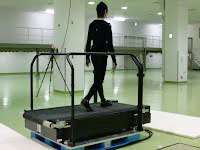Researchers study neurology of balancing on two legs

Walking on two legs is inherently unstable, meaning that the human central nervous system must work hard to maintain balance. Walking motion is maintained by two control approaches—feedforward control, in which the body anticipates possible disturbances to steady walking, and feedback control, when the body reacts to an unseen disturbance to stay upright. The precise mechanisms underlying these control approaches are not yet fully understood.
To uncover variables underpinning feedback control, Tetsuro Funato at the University of Electro-Communications, Tokyo, Japan, together with scientists from Kyoto University, used a technique based on 'uncontrolled manifold analysis' (UCM) —a way of quantifying the behavior of different multi-segmental motion, how their relationships are formed and how they are used in response to disturbances.
Funato and his team gathered data from 11 healthy male participants who were asked to walk steadily on a treadmill. The researchers sped up or slowed down the treadmill abruptly, with consecutive disturbances occurring either frequently (within one walking cycle) or gradually (over a few steps).
The team were interested in the significance of 'intersegmental co-ordination' on walking control - specifically, the interaction of the thigh, shank and foot during motion phases. They compared this with fluctuations in the participants' center of mass, head and limb axis during both steady and disturbed walking.
Their UCM-based results indicated that fluctuations in intersegmental co-ordination were smaller than center of mass, head and limb axis fluctuations. This suggests intersegmental co-ordination may play a significant role in a feedback control of walking by maintaining a continuous cyclic pattern regardless of disturbances.
More information: Tetsuro Funato et al. Validating the feedback control of intersegmental coordination by fluctuation analysis of disturbed walking, Experimental Brain Research (2015). DOI: 10.1007/s00221-015-4216-x















